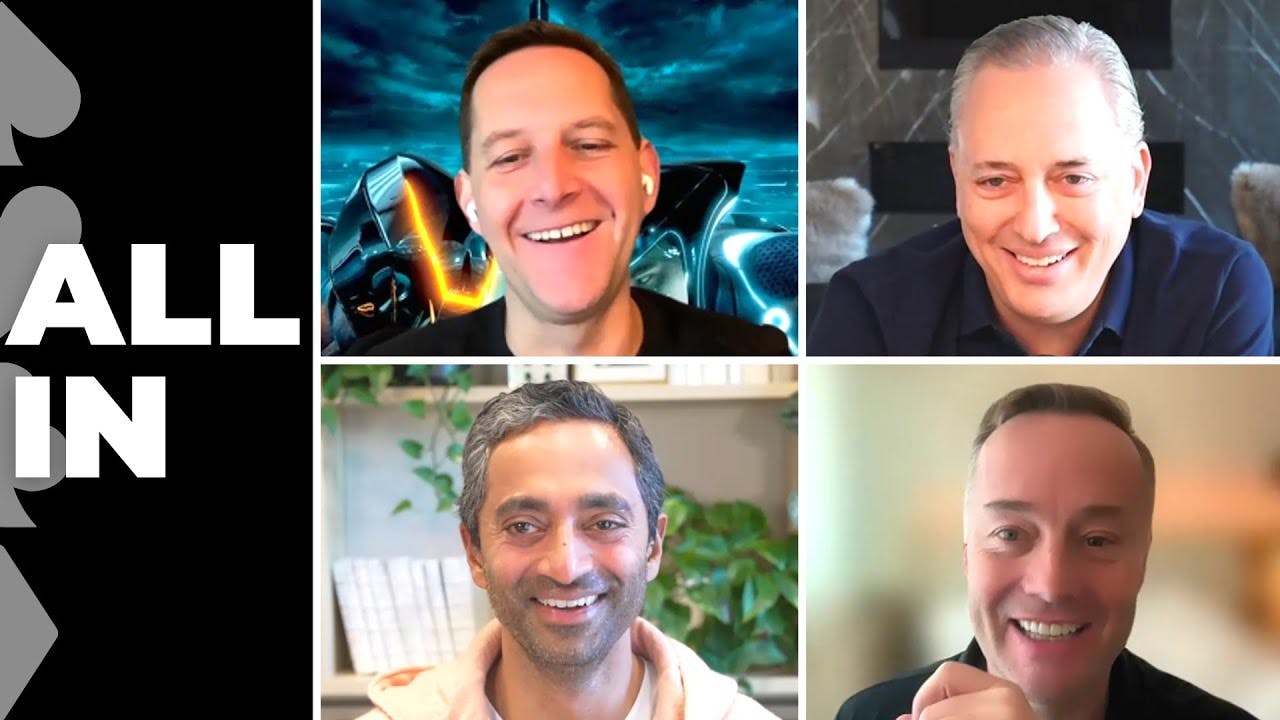E165: Vision Pro: use or lose? Meta vs Snap, SaaS recovery, AI investing, rolling real estate crisis
10 Feb 2024 (almost 2 years ago)

Bestie intros! (0s)
- David Sacks is back from his time in the metaverse.
- David tried the Apple Vision Pro.
- His kids love using it.
- The Oakland Apple Store was robbed.
- Stolen devices get bricked and have GPS tracking.
Apple Vision Pro breakdown (2m8s)
- The Apple Vision Pro has the potential to revolutionize industries by streamlining tasks, increasing productivity, and enhancing training, especially in enterprise settings.
- Spatial video recording can provide immersive training experiences, improving learning outcomes compared to traditional methods.
- While VR/AR devices like Meta's Vision Pro can enhance productivity, excessive use may exacerbate negative outcomes observed in young people, such as depression and social isolation.
- Despite its high cost, Apple's Vision Pro has sold 200,000 units and is projected to sell half a million this year, with an estimated 100 billion units of the Vision Pro and its successor to be sold within the next five years.
- The movie-watching experience on the Vision Pro is superior to watching on a TV, especially for 3D content.
- VR headsets may not become as ubiquitous as devices like iPads or phones due to their unique characteristics and limitations, such as being very personal devices and potentially impacting social interaction and childhood development.
- Companies like Bumble and Tinder could benefit economically by targeting the same demographic as the Vision Pro.
Meta vs Snap: god-king CEO, dependent on ad revenue, drastically different performance (20m46s)
- Meta's shift in focus to AI and cost-cutting measures has led to increased quarterly profits and an all-time high stock price.
- Snap's imbalanced voting rights structure, which gives the executive team excessive control, has discouraged feedback from common shareholders and contributed to its underperformance.
- Snap's operating expenses have significantly increased, leading to lower operating income, despite slight increases in total revenue and gross profit from 2021 to 2023.
- Snap's recent 10% headcount cut is seen as insufficient, as the company needs a 25% reduction to return to its 2021 operating expense level.
- Meta's profitability allows it to invest heavily in AI, making it a leader in the field, while Snap lacks a feedback loop that encourages investors and analysts to engage with the company.
- Meta has the advantage of leveraging its infrastructure for third-party developers and applications, similar to Amazon's AWS, and is the largest advertising platform next to Google.
- Meta's ability to engineer solutions and drive advertising revenue up to $40 billion despite challenges demonstrates the quality of its engineering team.
Positive signals indicating a big SaaS bounceback (32m53s)
- There are signs of a potential recovery in the Software-as-a-Service (SaaS) sector after a period of deceleration and negative growth.
- Big Tech Cloud platforms like AWS, Azure, and Google Cloud are showing an increase in net new ARR (Annual Recurring Revenue) in Q4, indicating a bottoming out and subsequent reacceleration of growth in the SAS sector.
- Companies are now more willing to spend on SAS solutions, as the psychological impact of the past two years, where customers were consolidating vendors and reducing SAS spending, seems to be easing.
- The market is recovering from the downturn, but the recovery will be slow, as companies are still cutting software costs to save money during the economic downturn, leading to price compression for SaaS companies.
- The adoption of software is expected to continue to grow, but there will be more competition in the market, as some companies are choosing to build their own software instead of buying it.
VCs are split into three camps on how to approach AI investing (41m6s)
- Open source AI models will reduce the economic value of closed models trained on open data, but their utility will increase significantly.
- Companies providing tokens per second services, similar to Amazon's EC2 and S3, are well-positioned to profit in the AI era, especially those with proprietary hardware.
- AI investing can be divided into three categories: models, infrastructure, and applications.
- OpenAI's lead in the consumer GPT market may be sustainable due to its slight edge over open-source models and its attractive audience for developers.
- For AI-powered applications to succeed, both the quality of the model and its speed and responsiveness are crucial.
- OpenAI has three different businesses: a closed model trained on the open internet, a consumer-facing app called ChatGPT, and selling enterprise services to large companies.
- The key to success in the AI language model market will be providing the same level of quality at the lowest cost.
- YouTube has a significant data advantage in video content, with an estimated 2,000 to 3,000 petabytes of data and a daily upload rate of 1 to 2 petabytes.